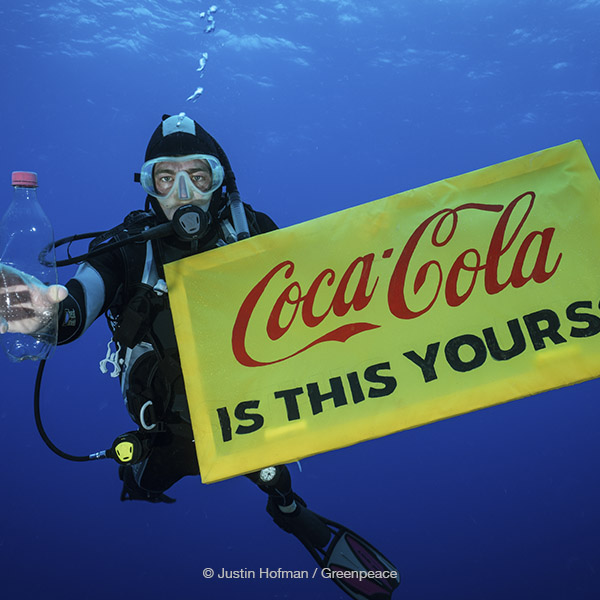From the Executive Director

Over the past few months our investigations, research, and analysis have shown clearly what our planet needs for a healthy, livable future. Greenpeace has released several new reports on our priority campaigns to protect the oceans, make the climate crisis a top 2020 U.S. presidential campaign issue, and hold corporations responsible for trashing the planet with plastic pollution.
In what is arguably the most important Greenpeace oceans report ever issued, 30×30: A Blueprint For Ocean Protection, leading scientists and researchers broke down the global oceans and mapped the distribution of hundreds of different conservation features, generating scenarios for what a planet-wide network of ocean sanctuaries, free from harmful human activity, could look like. It shows that it is entirely possible to do what science tells us we must—fully protect at least 30% of the world’s oceans by 2030—if we’re going to keep wildlife from going extinct and save the climate.
That’s the goal of Greenpeace’s Protect the Oceans campaign, and the 30x30 report is helping us make the case for a strong Global Ocean Treaty with world governments in the lead-up to its finalization a year from now.
For our climate campaigns, original new Greenpeace analysis demonstrates that climate progress is impossible without confronting the fossil fuel industry. Our report, Real Climate Leadership: Why The Next President Must Prioritize A Fossil Fuel Phase Out, illustrates that if no action is taken to address the climate impacts of fossil fuel production, then a significant fraction of emissions reductions achieved by policies to reduce demand for fossil fuels could be wiped out.
For the next president and Congress, real climate leadership means not only saying yes to real solutions like a rapid transition to renewable energy with equitable ownership and participation but also saying no to the destructive impacts of fossil fuel extraction.
And for our campaign for a plastic-free future, in Packaging Away the Planet, for the first time Greenpeace ranks 20 large U.S. grocery retailers on their efforts to address the plastic pollution crisis and their contributions to it. Although some grocers have taken positive steps, none of them scored above 35 out of 100—they all have a long way to go.
Your support is what makes these reports and Greenpeace’s quality in-depth research and analysis possible alongside all of our essential work to protect oceans, defend forests, save wildlife, stabilize the climate, and put people and the planet before corporate profits. Thank you!
For a green and peaceful future,

Annie Leonard, Executive Director
Greenpeace USA
Our Mission
Greenpeace, Inc. is the leading independent campaigning organization that uses peaceful direct action and creative communication to expose global environmental problems and promote solutions that are essential to a green and peaceful future. Please visit greenpeace.org to learn more about Greenpeace, Inc., and greenpeacefund.org to learn more about Greenpeace Fund, Inc.This update is intended to provide a comprehensive summary of all Greenpeace campaign activities. Please note that all donations to Greenpeace Fund, Inc. were solely used in connection with 501(c)(3) permissible activities. ISSN: 8899- 0190. Unless otherwise noted, all contents are © Greenpeace, Inc.

















 Tech Titans Demand Clean Energy—Following the release of Greenpeace’s Clicking Clean Virginia report documenting the dirty energy powering “Data Center Alley” in Northern Virginia, cloud computing and internet giants sent a joint letter demanding Dominion Energy invest in renewable energy. Amazon, Microsoft, Apple, and other tech giants have now clearly and publicly rejected Dominion’s plan to meet their energy needs with fracked gas through the Atlantic Coast Pipeline. These tech companies and their customers are demanding the utility focus instead on renewable energy solutions. This pipeline has been rejected by the public, the courts, and now the very customers Dominion claimed it was for.
Tech Titans Demand Clean Energy—Following the release of Greenpeace’s Clicking Clean Virginia report documenting the dirty energy powering “Data Center Alley” in Northern Virginia, cloud computing and internet giants sent a joint letter demanding Dominion Energy invest in renewable energy. Amazon, Microsoft, Apple, and other tech giants have now clearly and publicly rejected Dominion’s plan to meet their energy needs with fracked gas through the Atlantic Coast Pipeline. These tech companies and their customers are demanding the utility focus instead on renewable energy solutions. This pipeline has been rejected by the public, the courts, and now the very customers Dominion claimed it was for. In the evening as the oil rig prepares to leave Scotland’s Cromarty Firth, Greenpeace climbers scale it, stopping it in its tracks, and hang a banner displaying the only two words needed to describe the madness of drilling for more oil—Climate Emergency.
In the evening as the oil rig prepares to leave Scotland’s Cromarty Firth, Greenpeace climbers scale it, stopping it in its tracks, and hang a banner displaying the only two words needed to describe the madness of drilling for more oil—Climate Emergency. Two activists, Fran and Jo, remain on a platform on a leg of the rig, below the main deck. Pete and Tom swap in that evening and have provisions to stay in place for days.
Two activists, Fran and Jo, remain on a platform on a leg of the rig, below the main deck. Pete and Tom swap in that evening and have provisions to stay in place for days. Greenpeace UK is served an interdict—the Scottish law equivalent of an injunction—in an effort to prevent the continuing rig occupation. Rig workers attempt to lower the injunction to the two activists via a bucket and rope.
Greenpeace UK is served an interdict—the Scottish law equivalent of an injunction—in an effort to prevent the continuing rig occupation. Rig workers attempt to lower the injunction to the two activists via a bucket and rope. The oil rig remains occupied and unable to move.
The oil rig remains occupied and unable to move. Scottish police start attempts to remove the activists. Ever resourceful, one activist attaches to the anchor chain. By evening, police boats and climbers manage to remove both.
Scottish police start attempts to remove the activists. Ever resourceful, one activist attaches to the anchor chain. By evening, police boats and climbers manage to remove both. At 4 a.m. a fresh team of Greenpeace UK climbers re-board the BP oil rig, just hours after police declared the occupation over. This pair of activists, Meena and Andrew, occupy the rig all day, but by the evening the police have removed them. Shortly afterwards, the Transocean rig is towed out of the Cromarty Firth on its way to the intended drilling site.
At 4 a.m. a fresh team of Greenpeace UK climbers re-board the BP oil rig, just hours after police declared the occupation over. This pair of activists, Meena and Andrew, occupy the rig all day, but by the evening the police have removed them. Shortly afterwards, the Transocean rig is towed out of the Cromarty Firth on its way to the intended drilling site. Injunctions are in place against Greenpeace ships. Defiantly, the Arctic Sunrise is on course to Scotland, racing northward up the east coast of the UK, trying to catch up with the oil rig. A climbing team from Greenpeace Germany is on board. Across the UK solidarity protests with “Climate Emergency” banners start happening outside BP gas stations.
Injunctions are in place against Greenpeace ships. Defiantly, the Arctic Sunrise is on course to Scotland, racing northward up the east coast of the UK, trying to catch up with the oil rig. A climbing team from Greenpeace Germany is on board. Across the UK solidarity protests with “Climate Emergency” banners start happening outside BP gas stations. The Arctic Sunrise catches up with the oil rig in the North Sea. In an unexpected twist, the rig performs a U-turn and starts heading back to Scotland’s coast.
The Arctic Sunrise catches up with the oil rig in the North Sea. In an unexpected twist, the rig performs a U-turn and starts heading back to Scotland’s coast. Just a few miles from the drilling site and having travelled more than 500 nautical miles back and forth, Greenpeace activists force the third U-turn and the rig is now heading back towards the shore. Two rigid hull inflatable boats (RHIBs) are deployed from the Arctic Sunrise with activists on board holding banners reading “Climate Emergency” as our action blocks BP’s operation for the 10th day in a row.
Just a few miles from the drilling site and having travelled more than 500 nautical miles back and forth, Greenpeace activists force the third U-turn and the rig is now heading back towards the shore. Two rigid hull inflatable boats (RHIBs) are deployed from the Arctic Sunrise with activists on board holding banners reading “Climate Emergency” as our action blocks BP’s operation for the 10th day in a row. An experienced Greenpeace International swimmer takes to the sea from the Arctic Sunrise, putting herself between the drill site and the rig, trying to prevent it from anchoring. The Arctic Sunrise remains in the vicinity of the rig, which reaches its destination, bearing witness to BP’s contribution to the climate emergency.
An experienced Greenpeace International swimmer takes to the sea from the Arctic Sunrise, putting herself between the drill site and the rig, trying to prevent it from anchoring. The Arctic Sunrise remains in the vicinity of the rig, which reaches its destination, bearing witness to BP’s contribution to the climate emergency. The standoff between Greenpeace and BP is brought to a close with a series of coordinated protests targeting the company in Europe and the U.S.
The standoff between Greenpeace and BP is brought to a close with a series of coordinated protests targeting the company in Europe and the U.S.


 Will McCallum, Head of Oceans at Greenpeace UK, was on board a research vessel off the coast of Antarctica recently when his team found the first documented pieces of plastic in this seemingly pristine and remote region. This inspired him to write How to Give Up Plastic: A Guide to Changing the World, One Plastic Bottle at a Time, which was published by Penguin Books this July. In it, McCallum has produced a straightforward, practical guide to cutting plastic out of your life. You’ve read about Greenpeace’s efforts to fight plastic pollution in our cover story, so pick up a copy of How to Give up Plastic to learn more about what you can do personally to help.
Will McCallum, Head of Oceans at Greenpeace UK, was on board a research vessel off the coast of Antarctica recently when his team found the first documented pieces of plastic in this seemingly pristine and remote region. This inspired him to write How to Give Up Plastic: A Guide to Changing the World, One Plastic Bottle at a Time, which was published by Penguin Books this July. In it, McCallum has produced a straightforward, practical guide to cutting plastic out of your life. You’ve read about Greenpeace’s efforts to fight plastic pollution in our cover story, so pick up a copy of How to Give up Plastic to learn more about what you can do personally to help.
